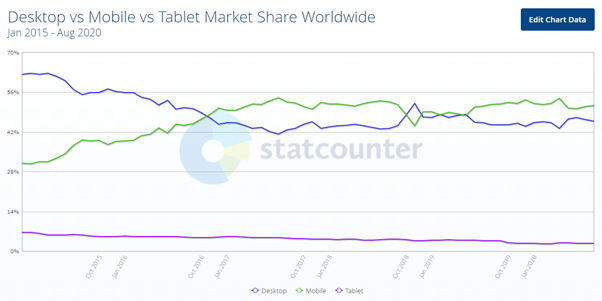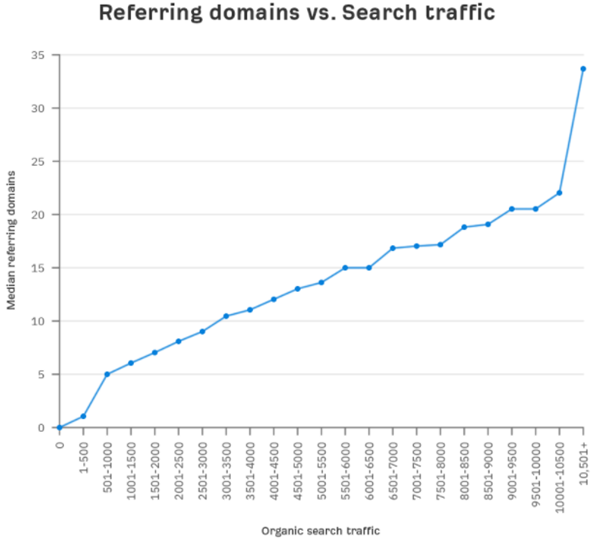24 Powerful SEO Statistics You Need To Know

SEO is constantly changing and it’s hard to keep up with it. If you want your website to achieve great success on Google, SEO statistics can give you lots of useful hints – learn from them and boost traffic to your website. In this article, I have prepared 24 key SEO statistics for you. Explore the latest trends in backlinks, keywords, local SEO, or mobile SEO. Let’s kick things off with these powerful SEO statistics!
General SEO Statistics
1. Google is invincible
Google has been a world leader for many years… and this trend is actually continuing! Currently, Google covers as much as 86% of the global search market, leaving competitors far behind. In second position is Bing (6.43%), then: Yahoo! – 2.84%, Baidu – 0.68% and Yandex – 0.63%. As you can see, Google is simply unbeatable.

2. Search engines generate massive web traffic
Both organic and paid search dominated website traffic in 2019 – it is estimated that as much as 68% of global website traffic came from search engines. The organic search itself covers 53% of overall traffic and the paid search – 15%. Only 5% of traffic comes from organic social.
3. The #1 result in Google has the highest CTR
This will probably not come as a surprise to most of you, but the position in the search results really has an impact on CTR. Of course, most users click on #1 result – it gains 31.7% of all clicks. With each next position in the search results, the CTR drops dramatically to the point that only 0.78% of all searches clicked on anything on the second page of the search results.

4. Sites without meta description in TOP10
Meta description, just like title tag, heading structure or alternative text to images is one of the first and at the same time key elements that require optimization. However, it turns out that 25.02% (so basically one in four web pages) of pages in TOP10 does not have a meta description at all. Quite a surprise, right?
5. Old pages rank higher in the search results
As demonstrated by the survey conducted by Ahrefs, the average page appearing in TOP10 in the search results is 2+ years old. It turns out that the older the page, the greater the chance for high ranking in the search results. The average #1 page is almost 3 years old. What’s interesting, only 22% of the pages that are in TOP10 are less than 1 year old.

6. Google algorithm updates
Google frequently updates its algorithms so that the search results meet users’ needs and expectations more accurately. This search engine has been improving its algorithms for years, so since 2003, there have already been around 70 known Google algorithm updates. Of course, there could be much more but less noticeable updates. The most common and most visible consequence of algorithm updates is a sudden change in the ranking in search results.
7. Google ranking factors
Many factors determine whether your website is successful in the search engine and increases visibility in search results, and as a result, boosts organic traffic. We know over 200 ranking factors used by Google in its algorithms. Most of them are officially announced by Google, while some are just speculations. These factors mainly concern domain, backlinks, user interaction, brand signals, or on-site elements.
If you want to check how to influence the search engine, on our blog you will find a list of the most important Google ranking factors.
8. Searches in Google in 2020
The number of searches in Google is growing year after year. Let’s compare the number of searches on Google in 2016 and 2020. How has this changed over the last few years?

Although these are just estimations, as Google doesn’t provide the exact search number, it can be seen that this is an upward trend, which will probably continue in the following years as well.
Local SEO Statistics
9. Local searches in Google
A large part of mobile searches is location related – as much as 30% of all them are related to the businesses located nearby. Users usually type local searches such as “stores open now”, “food open now” as well as “where to buy/find/get”, etc.
10. Local searches result in conversion
Local searches do not always result in an immediate purchase, but quite often bring people directly to local businesses. 76% of people who search in Google for a business located nearby (in the neighborhood or in the city) visit the business within one day. What is more, 28% of local searches result in making a purchase. As you can see, they have really great potential for generating revenue, not only online but also directly.
11. On-site SEO factors of small business websites
Fresh Chalk analyzed 150 thousand small business websites to check their basic on-site SEO factors, such as title tag, robots.txt, meta description, H1 heading, schema.org, and sitemap.xml. Their analysis shows that virtually every website has a title tag (99%), followed by robots.txt (88%) and sitemap.xml (73%). What is surprising, only 68% of small business websites had H1 heading, which is one of the most important structural elements. Also, schema.org is not frequently implemented (44%).

12. Google My Business
Google My Business is an additional feature introduced by this search engine, where local companies can add the most important information: reviews, contact info, opening hours, address, etc.
What’s interesting, there is a correlation between Google My Business reviews and ranking in the search results. The median Google ranking of the websites with 4-5 stars is 33, in turn, businesses with 1-3 stars are on average in the 41st position.
Mobile SEO Statistics
13. Mobile web traffic
Mobile devices are becoming more and more important in generating worldwide web traffic. It turns out that actually more web traffic comes from mobiles than from desktops, leaving tablets far behind. In August 2020, mobile devices took over half of the market share worldwide (51.33%), whereas desktops – 45.9%, tablets – only 2.78%.

Let’s see how the situation has changed from the beginning of 2015 until today. Until 5 years ago, desktops were leaders in the market. Over time, however, their popularity was decreasing, making mobiles more popular among users. November 2016 was the first month in which mobile devices won over desktops. Still don’t you believe that mobile SEO has a huge power to generate traffic to your website? The numbers speak for themselves.

14. Positions in Google search results
The position in the search results plays an important role in mobile searches as well. The #1 position in the ranking on mobiles gives a 27.7% chance to be clicked, with each subsequent position these chances fall. For example: position #2 – 9.2%, position #5 – 4.8%, position #10 – only 2.8%. As you can see, practically nobody clicks on the last position on the first page of the ranking.
15. Mobile phone search users in the U.S.
The number of users in the United States who use mobile devices to search for information on Google is also growing year after year. In 2014, more than 133 million people in this country used the Internet search engine on mobiles, while in 2020 there are as many as 221 million. This number is increasing every year, which is why we can assume that this trend will continue in the following years as well.

Video SEO Statistics
16. Video as a content strategy
It turns out that video is the most popular form used in content strategies. Almost 20% of marketers admit that they implement this type of content. More than 15% claim that they use blogs, a bit less – infographics and case studies. However, the most popular types of video content are brand storytelling, product or service promotion, and product demos.
17. User engagement and YouTube ranking
Do you want your video content to hit YouTube and appear high in the ranking? You must take care of user engagement. It turns out that there is a correlation between the number of comments, likes, shares, and views and the position in the YouTube ranking. Apparently a similar situation happens with the length of the videos – the average length of the video on the first search page is 14 minutes and 50 seconds. YouTube simply likes long videos!
In the chart below, you can see that the relationship between the number of views and YouTube ranking is actually real:

18. YouTube statistics
Here are some key YouTube statistics that will show you how powerful this platform is:
- total number of monthly active users on YouTube: 2 billion,
- total number of daily active users on YouTube: 30 million,
- total number of users who create content on YouTube: 50 million,
- total number of videos watched per day: 5 billion,
- as many as 62% of companies use YouTube,
- 95% of all Internet users watch videos on YouTube.
Backlink Statistics
19. Pages with no backlinks
Backlinks are, in fact, one of the main Google ranking factors, however, many people tend to forget about it, and, as a result, as many as 66.31% of pages have no referring domains. What’s more, 26.29% of pages have only 1-3 backlinks, it’s still not enough. It is worth mentioning that Ahrefs has drawn these conclusions based on 1 billion pages, which are in the Content Explorer Index.
20. Backlinks and organic traffic
This may not come as a surprise to you, but the number of backlinks really has an impact on organic traffic. To put it simply: the more backlinks a page has, the more organic traffic it gains from Google. Just take a look at this chart:
Sites with a large number of referring domains gain Google’s trust, which rates them as high quality and rewards with top positions in the search results. The survey conducted by Ahrefs clearly shows that backlinks can effectively help in building organic traffic.
21. Blog content and backlinks
Backlinko analyzed 912 million blog posts and drew some very interesting conclusions from this:
- a large part of blog posts have very few or absolutely no backlinks – 94% of them have zero referring domains,
- if you want to gain a lot of backlinks, choose long-form content – it gains on average 77.2% more backlinks than short-form content,
- there is a correlation between the length of headline and social shares – long headlines ( around 14-17 words) get over 76% more social shares.
Keyword Statistics
22. Keywords as questions
Search queries in the form of questions are not the most common choice of users. Only about 8% of search queries come as questions. The most common questions types by users start with “who”, “where”, “when”, “what”, “why” and “when”.
23. The most popular keywords in the U.S.
The Americans most often search for brand-related keywords. Here is a list of keywords with the highest search volume in the United States:

24. Keywords with few monthly searches
Ahrefs analyzed 1.9 billion search queries and noted that the vast majority (92.42%) have 10 monthly searches or even less. Between 11 and 100 have 6.01% of keywords, and what’s interesting, only 0.01% of them have a search volume greater than 10000.

Conclusions
Statistics are not just about numbers, they are meant to draw some conclusions from them. I hope that these stats I presented here will be useful for you when working out SEO strategies for your website. Which of these statistics surprised you the most? Or maybe you want to add some great stats from SEO that I overlooked? Give me feedback and let me know in your comments!






Great data selection, Matt. Quite an eye-opener on the potential that lies within SEO for me.